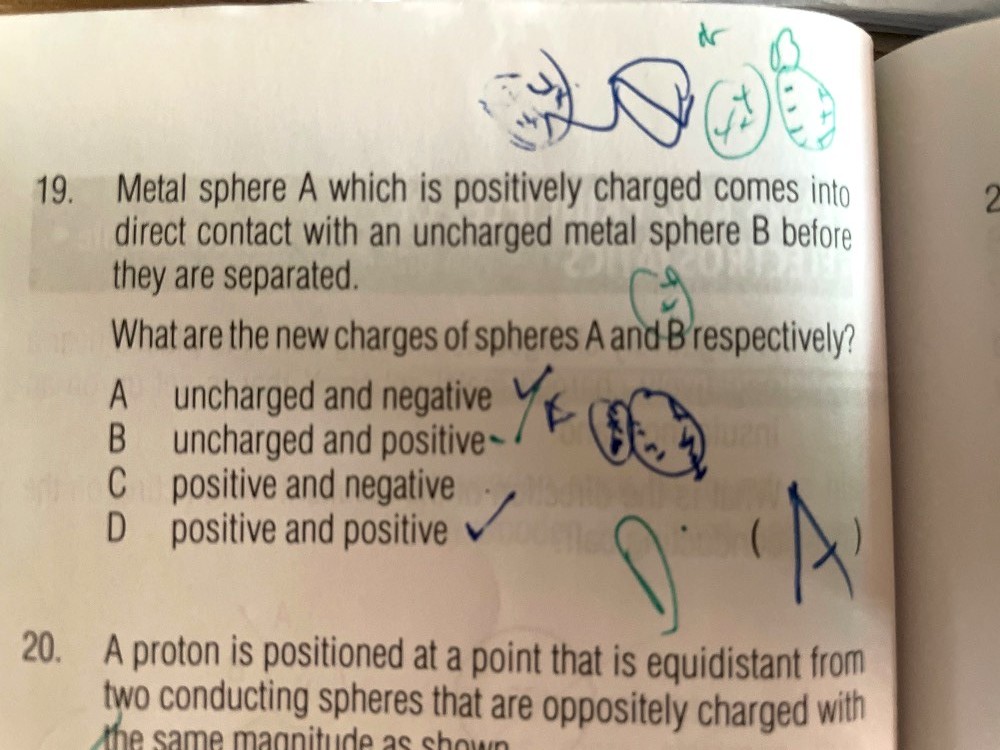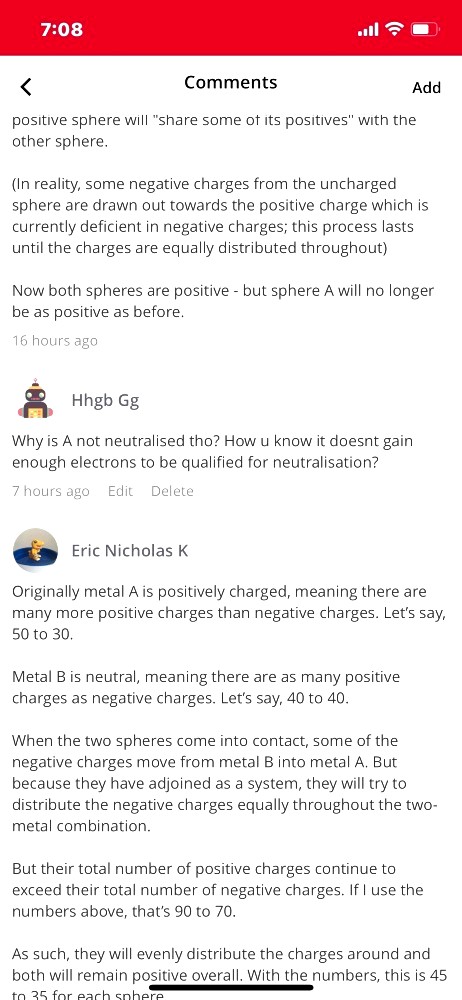Ask Singapore Homework?
Upload a photo of a Singapore homework and someone will email you the solution for free.

Question
secondary 4 | A Maths
One Answer Below
Anyone can contribute an answer, even non-tutors.

Why is ans D
Note that both spheres are metals so charges readily move. The spheres come into contact with each other, so the positive sphere will "share some of its positives" with the other sphere.
(In reality, some negative charges from the uncharged sphere are drawn out towards the positive charge which is currently deficient in negative charges; this process lasts until the charges are equally distributed throughout)
Now both spheres are positive - but sphere A will no longer be as positive as before.
Metal B is neutral, meaning there are as many positive charges as negative charges. Let’s say, 40 to 40.
When the two spheres come into contact, some of the negative charges move from metal B into metal A. But because they have adjoined as a system, they will try to distribute the negative charges equally throughout the two-metal combination.
But their total number of positive charges continue to exceed their total number of negative charges. If I use the numbers above, that’s 90 to 70.
As such, they will evenly distribute the charges around and both will remain positive overall. With the numbers, this is 45 to 35 for each sphere.
A connected system will work its way to an overall well spread-out system of charges. Even if A gains charges momentarily, B will kind of absorb the negative charges.
You won’t be able to have a two-metal connected system with differing charges because negative charges from both spheres can move around the entire system.
No extra electron from outside the spheres can come into the system. This makes A and B positive - but A’s positiveness is weakened because of the absorption of some negative charges.
In my previous example with a total of 90 positive and 70 negative charges, the whole system has a net +20 count of positive charges.
If A is forced to become negative, B will become very positive to keep the whole system count +20. But this is imbalanced - and then the electrons will move around again until both share the distribution.
Do you remember that the government provided $320 million help to the tourism sector in the form of rediscover vouchers? [Applies for adults over age 18, so if you ask any of them they should know]
Even as the government provides the help to alleviate the issues, the government does not simply give out all of their resources become “in the negative” in the pursuit of boosting the tourism industry. Having the government giving out the resources is like forcing sphere A to become negative - which isn’t exactly going to be logical.
Thank u for taking the time to explain.
But the qn states “ they are separated afterwards”. Cant i just use this idea to assume that both are positively charged hence the repulsion?
Normally when they are separated, they do not actually have sufficient time to “react”.
Imagine a group of friends, with equal number of girls and boys. Suddenly, a K-pop band comes. Somehow, the group are amazed by the K-pop band then the K-pop band joins the group of friends, talking to one another.
Suddenly, there is an earthquake splitting the ground into two equal parts. By the time everyone recognises this, it becomes too late - the group gets separated into two sections, with some of the group members and some of the K-pop members on one side and the remaining on the other half. There would be no time for the K-pop members to regroup themselves as everything comes in a flash.
This is actually what happens for charges - the charges themselves “are unaware” that the sphere are going to be split.
Though I believe by “separated” here the question is trying to say “manual separation by a human”.
See 1 Answer





